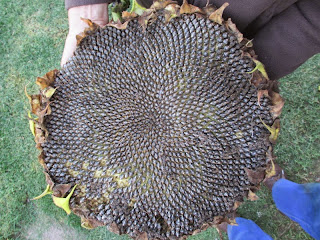During the week I was back at the farm with the tall, deep red Ericas and took some more pictures of them in a more advanced state:
The general feeling seems to be that they are probably E.pilansii
There was also a Pelargonium with the tiniest of flowers:
And lots of these on the north-facing slopes, a kind of Metalasia, perhaps? The leaves are quite spiky:
At home, Pippa picked her biggest Sunflower, Helianthus anuus. It measures 330mm across. Just look at the Fibonacci sequence in the layout of the seeds!
Down at the dam next door, the single Spoonbill was at the limit of my lens' capacity:
Here I managed to freeze a bee collecting pollen (or nectar?) from a tiny Erica flower:
The Stoebe plumosa or Seriphium plumosum (slangbos) is in full flower, filling out and turning brown:
We are fairly sure that these shrubs in one area are Brabejum stellatifolium or Wild Almond, as in van Riebeeck's Hedge:
Here are some flowers in a quite advanced state, let's see if they set 'almonds'. The toothed leaves can be seen here:
The Wachendorfia paniculata are coming up, their leaves already show their characteristic pleats:
The low sun was catching the spiders' webs between these pines which are about to be felled. Unfortunately, although stronger than a steel cable size for size, they won't save the trees.
The Ericas are still stunning!
All over, the Oxalis are out:
This Liparia splendens is likely to be in full sun if the forest is cut further, we hope it won't get too damaged in the process:
Likewise this Leucospermum oleifolium which we've been watching in the forest for a couple of years now. At least the gardening books say the less you tend them, the better they grow!
The Eikenhof Dam (our irrigation water) is being emptied at the moment for maintenance.
While we were up there, I thought I'd have a look at what we now think are Erica coccinea, with their spent flowers:
And look what we found in the process!
The flower is at the end of a very long stalk, there are only a few thin leaves at the base. Could they be Bulbinella trinervis? see http://www.ispot.org.za/node/192907?nav=parent_ob
I don't think anybody could deliberately make a garden feature as beautiful as this; a yellow Oxalis in a sandy hollow in the rock!
Could it be Oxalis luteola?
Lobelia are still to be seen all over. Here is one of the low-growing ones with the tangled stems:
We still haven't found a name for it!
While photographing this Prickly Pear or Opuntia, I noticed the Aphids crawling away between the spines behind the flower!
We're noticing more and more African Black Duck, Anas sparsa, than the familiar Yellow-bills lately:
Until next week.... :-) A
|
Sunday, 6 April 2014
Autumn Sunday Flower Walk
Labels:
Brajejum,
Erica,
Leucospermum,
Liparia,
Lobelia,
Metalasia,
new,
Oxalis,
Seriphium,
Stoebe,
Wachendorfia
Location:
Grabouw, South Africa
Subscribe to:
Post Comments (Atom)


























Once again some lovely photo, amazing colours still on the Ericas, the Oxalis in the rock is a magical find, as is the close u of the blue Lobelia. Excellent. As if that is not enough Andy then goes on to give us two wonderful photos of a Bulbinella trinervis and the Eikenhof Dam. Thanks for sharing.
ReplyDeleteThanks Bernard, we are very lucky to live in this beautiful place! :-) A
Delete